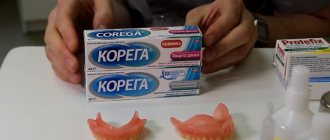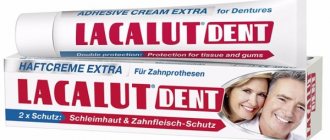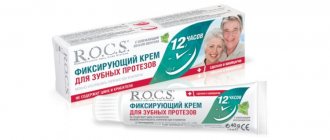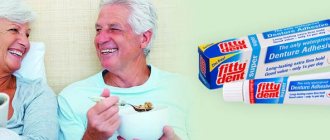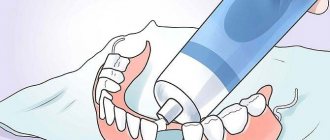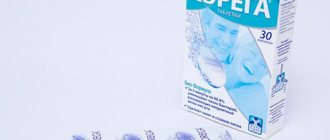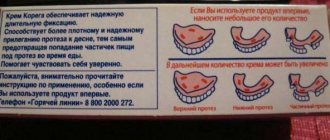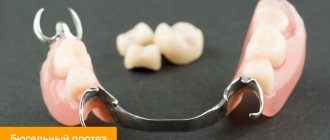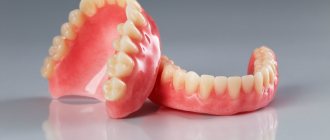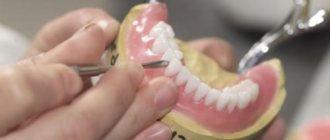One of the main problems that people with removable dentures face is insufficiently secure fixation. Despite careful individual selection, the structure can move while chewing food, talking, or laughing. This occurs due to insufficient adherence of the inner surface of the denture to the gum.
The solution to the problem is the use of special fixing substances. Today, the range of these products is widely represented in the windows of pharmacies and supermarkets. The products are produced in the form of a cream or gel.
Television advertising promises an immediate and long-lasting effect, but the consumer has a lot of questions: what to choose and should you believe the advertising?
Cream for fixing dentures
This is the most popular substance, suitable for all types of removable dental structures. Many customers ask the pharmacy for glue to fix dentures. But if you look at it, cream and glue are the same thing.
Yes, it really allows you to securely fix the removable structure on the surface of the gums. But which brand of denture bonding cream is best on the market?
Criteria for a quality fixing cream
- Duration of action
. The duration of fixation is one of the main characteristics. The instructions for modern creams state that they are able to hold a denture for 12-24 hours. It is more convenient when the fixation agent works all day long. In this case, there is no risk of unexpected detachment of the prosthesis at the most inopportune time. - Safety
. The fixing cream or glue should not contain substances that are toxic or damaging to the mucous membrane. This will ensure safe use of the product over a long period. - Structure
. Manufacturers specially produce fixing agents with different consistencies so that the consumer can choose the product for themselves. The gel is most often liquid, so it is easier to apply, but at the same time its consumption increases. Liquid products are recommended for the first time after dental prosthetics. Cream or glue has a thicker consistency. However, it must be applied in doses to the prosthesis, because an excess of the substance has a negative effect on the fixing properties. - Additional ingredients
. Thanks to the auxiliary components included in the cream, you can not only ensure reliable attachment of the denture, but also freshen your breath and reduce gum inflammation.
Data on allergies to domestic coronavirus vaccines
Data on Russian drugs obtained during the mass vaccination campaign:
- “Sputnik V” (vector adenoviral) – no cases of anaphylaxis. The medical product contains polysorbate 80; the instructions for use contain a warning that an allergy to the coronavirus vaccine is possible;
- “EpiVacCorona” (peptide) – no cases of anaphylaxis. Among the components is aluminum hydroxide, which is contraindicated for people with individual selective hypersensitivity, as well as severe allergies;
- CoviVac (inactivated) – no cases of anaphylaxis. The list of contraindications includes severe allergic reactions: anaphylaxis, Quincke's edema, eczema. For non-drug allergies, the drug can be administered.
Head of the Center named after. Gamaleya A. Gunzburg recommends that allergy sufferers, before starting vaccination, carry out tests for C-reactive protein and IgE immunoglobulins, which demonstrate the current risk of complications. A normal level of these indicators will guarantee the safety of vaccination even if there is a history of severe forms of allergies.
Cream "Korega" for dentures
One of the leaders in the fixing agents market. The line consists of 3 types:
- extra strong mint;
- neutral;
- refreshing.
According to data, it ensures fixation of a removable denture throughout the whole day. It comes with mint or neutral flavor. The cream does not contain zinc, so it can be used on an ongoing basis.
How to apply cream
Fixing cream for dentures "Korega" is applied in strips to the inside of the previously cleaned insert structure. It is also necessary to rinse your mouth to remove any remaining food.
After pressing the prosthesis to the gums, the product should not enter the oral cavity. After attaching the structure, it is not recommended to immediately start eating. For strong fixation, you need to wait 10-15 minutes.
Removing the prosthesis
Corega glue reliably fixes dentures, so it is possible that you will need to remove the structure yourself at the end of the day. It's easy to do:
- First you need to rinse your mouth with warm water.
- Then, using rocking movements, try to remove the denture from the oral cavity.
- If it is still fixed, you need to lightly press on the gum mucosa from the cheeks and remove the denture.
- After removing the denture from the oral cavity, it should be thoroughly rinsed using special products recommended by the manufacturer of the fixing cream.
Materials and methods
In order to scientifically substantiate the effectiveness of using this tool to improve the fixation of removable plate dentures of the full dentition, a series of studies were conducted to study its physical and mechanical properties [8] on the basis of the technical laboratories of the dental departments of the State Budgetary Educational Institution of Higher Professional Education “VSMU named after. N.N. Burdenko" and the dental materials production company Celit LLC (Voronezh).
Determination of the adhesive strength of the core material to the base and mucous membrane was carried out according to the method developed by I.Ya. Poyurovskaya, T.F. Sutugina, N.N. Urazaeva (1986). Especially for the experiment, sections of the pig intestinal mucosa were pre-frozen and cut out in the shape of a triangle measuring 7x7x7 cm. The adhesive composition was placed on a triangular plate made of Ftorax base plastic of the same dimensions as the prepared mucosal sample, and the material was evenly distributed over the surface. After this, it was covered on top with a triangular sample of the mucous membrane, previously moistened with water. For a tighter and more uniform fit, the entire structure was pressed with a load weighing 1 kg for 5 minutes. Next, the base plate with the coreg adhesive material and the mucous membrane was fixed in a stand so that the base of the triangle was parallel to the plane of the table. At the apex of the triangle, about 5 mm of the mucous membrane was peeled off and, having punctured it, a load weighing starting from 2 g was suspended, and a stopwatch was immediately started. After 60 s, the load was removed and the length (L) of the line at which peeling stopped was measured.
The adhesion force of the material to the substrate (P), balancing the load used, divided by the length of the line, characterizes the adhesive strength (A) of the material, which was calculated using the formula:
(g/cm)
Exactly the same experiment was carried out taking into account the influence of a humid environment, that is, after keeping the sample in water under a load for 1 hour. All tests were carried out in four parallels. The arithmetic mean of parallel tests was taken as the result.
The adhesive strength of the core composition to a base plastic plate was also determined using an IR 5040 tensile testing machine. To test the adhesive peel strength of the core composition to a metal disk with a diameter of 100 mm, a triangular-shaped substrate made of base plastic with sides of 43 mm was rigidly glued to a metal disk with a diameter of 100 mm using super glue. Next, a 0.5 g sample of the test material was applied on top of the dry surface of the base plastic and covered with a metal ring with an elastic film with a diameter of 100 mm. Then the sample was placed in a thermostat at 37C° (relative humidity 80%), a load of 5 kg was applied, and the holding time was 5 minutes. After this, the load was removed and the sample was removed from the thermostat. A metal ring with a rigid base was secured in a fixed clamp of an IR 5040 tensile testing machine, and a metal ring with an elastic film in a movable clamp using a metal fishing line. The tensile testing machine was turned on and a pull-out test was performed in such a way that the pull-out force acted perpendicular to the contact surface. The adhesive strength was calculated using the formula:
where Q is the value of adhesive strength; F—maximum load; S is the surface area at which deformation occurred.
The sample with the adhesive composition was subjected to 5 tests.
The determination of the time of fixation of the coreg adhesive material was carried out directly in the oral cavity of 18 patients with complete absence of teeth and with varying complexity of anatomical and topographic conditions of the prosthetic bed after 1 and 12 months of using well-fitted complete removable laminar dentures with an adhesive composition. To do this, all patients cleaned the oral cavity and dentures, after which the test adhesive composition was applied to the inner surface of the denture bases in an even thin layer. The dentures were inserted into the patients' oral cavity and pressed tightly against the gum mucosa for 30 s. Then the subjects were asked to open their mouths for 30 seconds by an average value of 20-25 mm, which corresponds to the distance between the cutting edges of the central incisors when biting off food. If during this time the prostheses did not move in relation to the prosthetic bed, then such fixation was assessed as sufficient. Every 30 minutes the patient underwent the above-described test. After an hour and a half of using the prosthesis, food was allowed (warm tea, gingerbread weighing 50 g). The experiment ended as soon as the time for fixing the prosthesis with the mouth open was reduced to 10 s.
Also, these patients underwent an objective examination and subjective data were assessed in order to determine the degree of fixation of removable dentures to the prosthetic bed with and without the use of coreg adhesive material, using the Ulitovsky-Leontiev prosthesis fixation index (DF), immediately after manufacture, as well as after 1 , 3, 6 months and a year of their use. For each patient, numerical index criteria were determined, which were assessed in parameters using a 5-point system (Table 1).
Table 1. Parameters of the fixation index of the Ulitovsky-Leontiev prosthesis
After this, this index was calculated using the formula:
Ulitovsky-Leontiev FP index (%) =
E (a1+…+ ap)
100.5n
where E is the sum of quantitative assessments of the criteria; а1 — number of points according to the first criterion; an — number of points according to the nth criterion; n is the number of criteria used in the index; 5—number of parameters to be evaluated within each criterion.
The evaluation of the results of determining the degree of fixation of removable dentures to the prosthetic bed with and without the use of an adhesive composition was carried out in accordance with the data presented in table. 2.
Table 2. Evaluation of the results of determining the Ulitovsky-Leontiev AF index
The obtained data were entered into tables of individual patient observation cards. Next, the indicators of the AF index determined at different times were summed up, after which a comparative assessment of the dynamics of the average indicator of the fixation index in the group was given.
Cream "Rox" for dentures
Another popular means for fixing dentures is Rox cream. This is a joint development of domestic and European specialists, capable of holding a removable structure for 12 hours even when drinking hot drinks. The mint extracts included in the composition freshen breath for a long time.
Among the features of the cream are:
- No dyes or zinc, which makes it safe for long-term use.
- Suitable for prostheses made of various materials. Rox glue is suitable for fixing dentures made of plastic, nylon and other composites.
- Economical. Due to the dense structure of the cream, consumption is minimal. One tube will last approximately 1.5-2 months.
- Application. Rox cream can be applied to both dry and wet dentures. This does not affect the quality of fixation.
- Availability. You can buy Rox cream for dentures in almost every pharmacy or supermarket.
The production of fixatives for dentures continues to develop, and new, better quality creams appear periodically. It is quite difficult to keep track of this on your own. Therefore, if you want to choose the best cream for fixing dentures, consult your dentist.
Gel for dentures
The range of gels for fixing dentures is quite limited, since they have a number of disadvantages compared to creams:
- Short fixation time. Due to the characteristics of the composition, the gel must be applied more often than cream, which causes some discomfort.
- Food restrictions. When attaching dentures with gel, it is not recommended to consume hot food or drinks.
- Big expense. The liquid consistency of the gel leads to increased consumption.
Gels are mainly used immediately after prosthetics, so that the patient learns to apply the correct amount of substance to the removable structure. When you press the prosthesis to the gum, the excess product will flow out on its own, but the fixation will still take place.
Which denture gel is best? A qualified dentist can answer this question. In any case, when choosing a product from a well-known manufacturer, you can be sure of its good quality.
Adverse reactions
The best cream for fixing dentures should not only be effective, but also not give adverse reactions even with long-term use. In case of an overdose of the drug, the following symptoms may occur:
- increased salivation;
- nausea, possible vomiting;
- general malaise;
- allergic reactions.
If you notice such manifestations, immediately visit your dentist: he will help you choose a remedy that will not cause unwanted reactions.
Possible allergens in vaccines
An allergic reaction is an abnormal response of the human body to the introduction of an allergen. Theoretically, any element of the vaccine could be such an allergen. The main component of the composition is the virus protein, and the auxiliary components are the components of the medium on which the vaccine was based, antimicrobial drugs, stabilizers or preservatives.
The most common allergies to vaccine protein are:
- vaccines against hepatitis B, as well as papillomavirus, contain yeast proteins, to which in minor cases a pathological reaction develops. The revealed increased sensitivity to a foreign protein is not a contraindication to the procedure;
- vaccines for influenza, rubella, measles, encephalitis and many others contain chicken egg protein. The development of allergies is minimal. For identified sensitization, a fractional version of the drug is recommended, as well as long-term post-vaccination observation;
- Anti-encephalitis vaccines and anti-rabies drugs contain the protein albumin. The procedure is similar to the above.
Reactions to the components formaldehyde, polyethylene glycol and gelatin are extremely rare.
